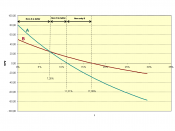There may be different objectives within firms, and we assume that increasing the value of the stock (or maximising share price and maximising shareholders' wealth) is the main objective of financial management. The most important approach we use to evaluate the optional investment is called the NPV (Net Present Value) rule. Normally we choose to estimate the present value of future cash flows we expect from the new project. Here we will use the basic discounted cash flow procedure to estimate the present value to those future cash flows, which is called discounted cash flow valuation. The net present value of and investment is the present value of the investment's future cash flows, minus the initial cost of the investment. If the net present value is positive, the investment is acceptable, because doing so is essentially the same as receiving a cash payment equal to the net present value.
If the net present value is negative, taking on the investment today is equivalent to giving up some cash today, and the investment should be rejected. The NPV approach is not the only method to evaluate an investment, other approaches, such as the payback rule, the average accounting return, the internal rate of return, etc, are also commonly used by firms. The payback rule is widely used by large firms, because of its convenience to calculate. What is the rationale of the payback rule? Generally speaking, it is based on the pay back period of an investment and compares it with the required payback period. The payback period is the length of time an investment takes to recover the initial investment, and the required payback period is usually decided by the firms. If the calculated payback period of an investment is less than the required payback period, then this...


